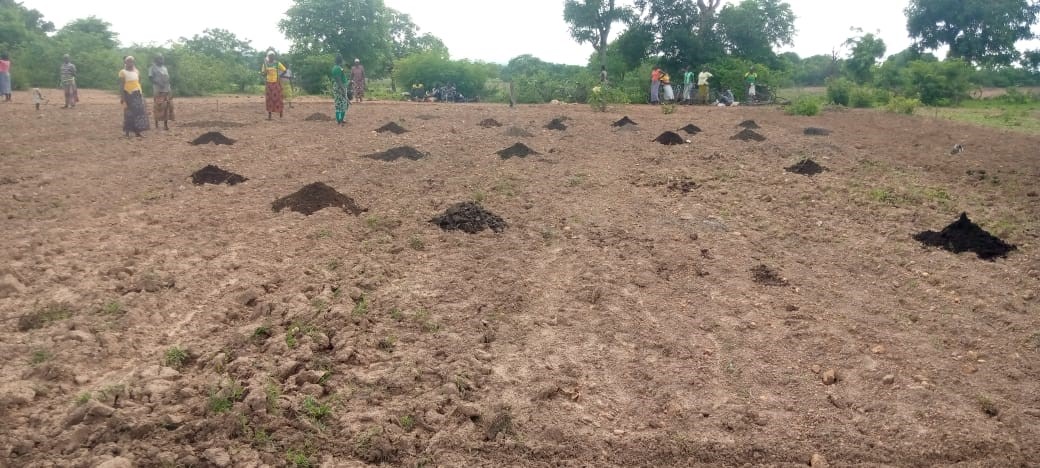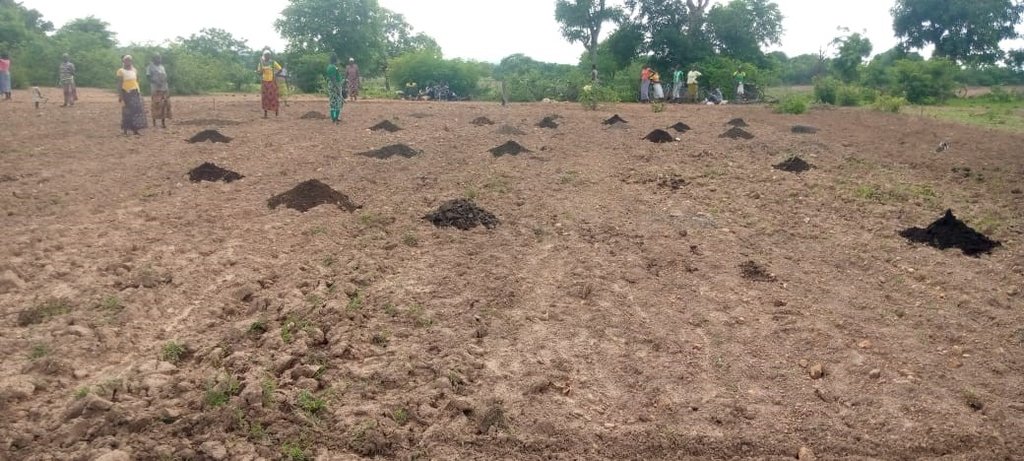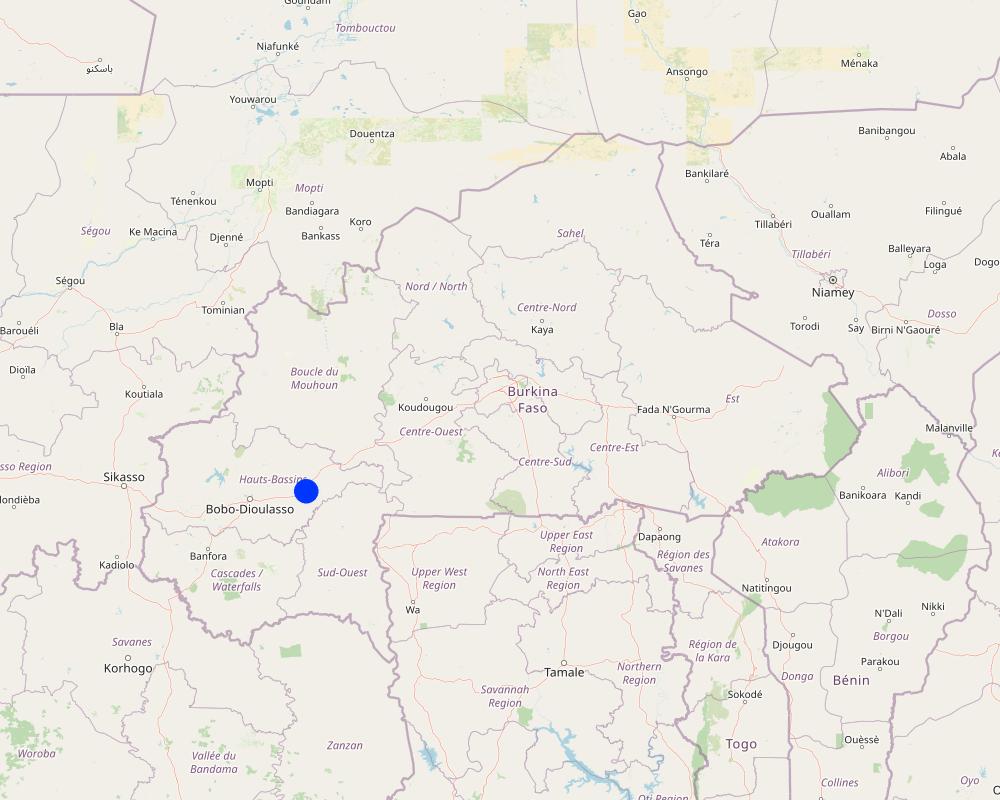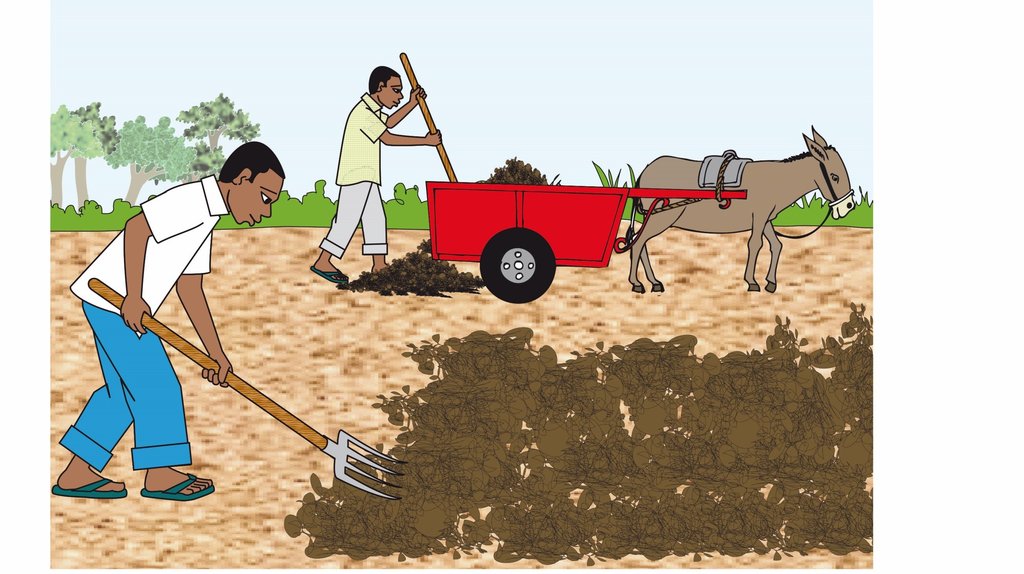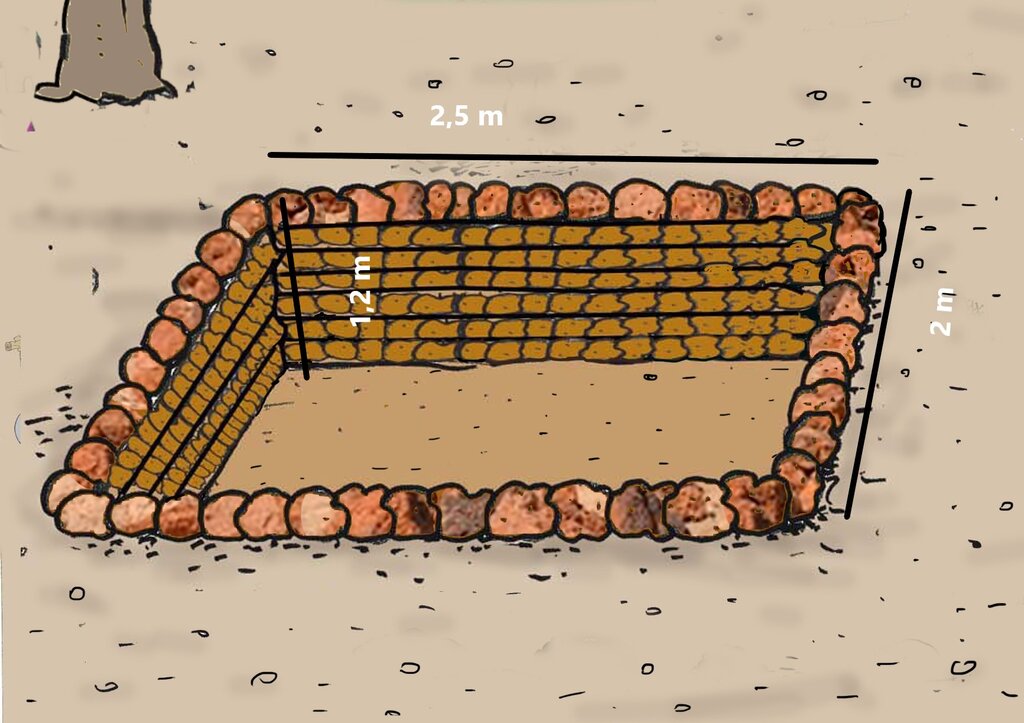Organic Manure-Based Fertilization [Burkina Faso]
- Creation:
- Update:
- Compiler: Moussa ABOU
- Editors: Brice Sosthène BAYALA, Siagbé Golli, Tabitha Nekesa, Ahmadou Gaye
- Reviewers: Sally Bunning, Rima Mekdaschi Studer, William Critchley
technologies_6704 - Burkina Faso
View sections
Expand all Collapse all1. General information
1.2 Contact details of resource persons and institutions involved in the assessment and documentation of the Technology
Key resource person(s)
land user:
OUEDRAOGO Abdoulaye
Burkina Faso
land user:
KABORE Abdoul Nassirou
Burkina Faso
Name of project which facilitated the documentation/ evaluation of the Technology (if relevant)
Soil protection and rehabilitation for food security (ProSo(i)l)Name of the institution(s) which facilitated the documentation/ evaluation of the Technology (if relevant)
Deutsche Gesellschaft für Internationale Zusammenarbeit (GIZ)1.3 Conditions regarding the use of data documented through WOCAT
The compiler and key resource person(s) accept the conditions regarding the use of data documented through WOCAT:
Yes
1.4 Declaration on sustainability of the described Technology
Is the Technology described here problematic with regard to land degradation, so that it cannot be declared a sustainable land management technology?
No
2. Description of the SLM Technology
2.1 Short description of the Technology
Definition of the Technology:
Organic manure-based fertilisation is a humus-rich soil improver. It is a soil amendment technology used to improve soil structure and fertility, thereby enhancing production quality.
2.2 Detailed description of the Technology
Description:
Organic manure is used as a fertilizer to improve soil quality, especially in fields with declining fertility. This agricultural technology is common worldwide.
Organic manure fertilization is a process that consists in enriching the soil by adding sufficient organic matter to improve both its physical and chemical properties. To apply this technology to cereal crops, good agricultural practice requires that each hectare be fertilized with 5 to 6 tonnes of well-decomposed organic manure in the first year, followed by 500 to 600 kg in subsequent years. Organic manure is applied by spreading it in heaps over the plot and then burying it when ploughing.
The purpose of organic manure-based fertilization is to enrich the soil by providing sufficient organic matter, improving the physico-chemical qualities of the soil. It helps to improve soil structure and fertility - and increases yields.
The main activities involved in organic manure-based fertilization are as follows:
• production of organic manure;
• transportation of organic manure;
• spreading of organic manure;
• mixing with the soil through ploughing.
The main inputs required to implement this technology are as follows:
• organic manure;
• carts;
• wheelbarrow;
• pickaxes;
• shovels;
• rakes.
Organic manure-based fertilization improves soil quality, retains water and nourishes plants. It has a positive impact on crop growth and yield increase.
According to farmers, this technology improves soil quality. However, there are constraints, including in processing organic materials and transporting organic manure.
2.3 Photos of the Technology
2.5 Country/ region/ locations where the Technology has been applied and which are covered by this assessment
Country:
Burkina Faso
Region/ State/ Province:
Hauts-Bassins region (Tuy province)
Further specification of location:
Koumbia (Commune of Koumbia)
Specify the spread of the Technology:
- applied at specific points/ concentrated on a small area
Is/are the technology site(s) located in a permanently protected area?
No
Map
×2.6 Date of implementation
Indicate year of implementation:
2019
If precise year is not known, indicate approximate date:
- less than 10 years ago (recently)
2.7 Introduction of the Technology
Specify how the Technology was introduced:
- through projects/ external interventions
Comments (type of project, etc.):
The technology was introduced by the Head of the Technical Support Zone (ZAT) for agriculture in the commune of Koumbia.
3. Classification of the SLM Technology
3.1 Main purpose(s) of the Technology
- improve production
- reduce, prevent, restore land degradation
- create beneficial economic impact
3.2 Current land use type(s) where the Technology is applied
Land use mixed within the same land unit:
Yes
Specify mixed land use (crops/ grazing/ trees):
- Agroforestry

Cropland
- Annual cropping
- Tree and shrub cropping
Annual cropping - Specify crops:
- cereals - maize
- cereals - other
- cereals - sorghum
Tree and shrub cropping - Specify crops:
- grapes
- karite (sheanut)
Number of growing seasons per year:
- 1
Is intercropping practiced?
No
Is crop rotation practiced?
Yes
If yes, specify:
Cotton, sorghum and maize
3.3 Has land use changed due to the implementation of the Technology?
Has land use changed due to the implementation of the Technology?
- No (Continue with question 3.4)
3.4 Water supply
Water supply for the land on which the Technology is applied:
- rainfed
3.5 SLM group to which the Technology belongs
- integrated crop-livestock management
- integrated soil fertility management
3.6 SLM measures comprising the Technology

agronomic measures
- A2: Organic matter/ soil fertility
- A3: Soil surface treatment
A3: Differentiate tillage systems:
A 3.3: Full tillage (< 30% soil cover)
3.7 Main types of land degradation addressed by the Technology

soil erosion by water
- Wt: loss of topsoil/ surface erosion

chemical soil deterioration
- Cn: fertility decline and reduced organic matter content (not caused by erosion)

biological degradation
- Bl: loss of soil life
3.8 Prevention, reduction, or restoration of land degradation
Specify the goal of the Technology with regard to land degradation:
- reduce land degradation
4. Technical specifications, implementation activities, inputs, and costs
4.1 Technical drawing of the Technology
Technical specifications (related to technical drawing):
•5 to 6 tons of well-decomposed organic manure per hectare in the first year;
•A 6 cubic metre pit corresponds to around 4.5 tons of organic manure, sufficient for 0.9 ha based on an application of 5 tons/ha ;
•500 to 600 kg in subsequent years;
•Even spreading
Author:
ProSoil/GIZ
Date:
2021
Technical specifications (related to technical drawing):
•Pit length: 2.5 m;
•Pit width: 2 m;
•Pit depth: 1.2 m;
•Pit volume: 6 cubic metre
Author:
ProSol/GIZ
Date:
2021
4.2 General information regarding the calculation of inputs and costs
Specify how costs and inputs were calculated:
- per Technology unit
Specify unit:
Pit
Specify dimensions of unit (if relevant):
10.8 cubic metre
If relevant, indicate exchange rate from USD to local currency (e.g. 1 USD = 79.9 Brazilian Real): 1 USD =:
613.5
Indicate average wage cost of hired labour per day:
CFA F 2,000
4.3 Establishment activities
| Activity | Timing (season) | |
|---|---|---|
| 1. | Production of organic manure | Dry season |
| 2. | Transportation of organic manure | Dry season |
| 3. | Spreading of organic manure | Dry season |
| 4. | Mixing in the soil through ploughing | Rainy season |
4.4 Costs and inputs needed for establishment
| Specify input | Unit | Quantity | Costs per Unit | Total costs per input | % of costs borne by land users | |
|---|---|---|---|---|---|---|
| Labour | Labor | Pit | 1.0 | 35000.0 | 35000.0 | 100.0 |
| Equipment | Gas pick | Number | 1.0 | 35000.0 | 35000.0 | 100.0 |
| Equipment | Shovel | Number | 1.0 | 2000.0 | 2000.0 | 100.0 |
| Equipment | Rake | Number | 1.0 | 5000.0 | 5000.0 | 100.0 |
| Equipment | Wheelbarrow | Number | 1.0 | 30000.0 | 30000.0 | 100.0 |
| Plant material | Fork | Number | 1.0 | 3000.0 | 3000.0 | 100.0 |
| Plant material | Watering can | Number | 1.0 | 2000.0 | 2000.0 | 100.0 |
| Plant material | Cart | Number | 1.0 | 125000.0 | 125000.0 | 100.0 |
| Construction material | Cement | Bag | 3.0 | 6500.0 | 19500.0 | 100.0 |
| Construction material | Brick | Number | 90.0 | 525.0 | 47250.0 | 100.0 |
| Other | Water | Barrel | 20.0 | 750.0 | 15000.0 | 100.0 |
| Total costs for establishment of the Technology | 318750.0 | |||||
| Total costs for establishment of the Technology in USD | 519.56 | |||||
4.5 Maintenance/ recurrent activities
| Activity | Timing/ frequency | |
|---|---|---|
| 1. | Watering | Dry season |
| 2. | Turning over the heap | Dry season |
4.6 Costs and inputs needed for maintenance/ recurrent activities (per year)
| Specify input | Unit | Quantity | Costs per Unit | Total costs per input | % of costs borne by land users | |
|---|---|---|---|---|---|---|
| Labour | Watering | Pit | 1.0 | 12000.0 | 12000.0 | 100.0 |
| Labour | Turning over the heap | Number | 6.0 | 2000.0 | 12000.0 | 100.0 |
| Total costs for maintenance of the Technology | 24000.0 | |||||
| Total costs for maintenance of the Technology in USD | 39.12 | |||||
4.7 Most important factors affecting the costs
Describe the most determinate factors affecting the costs:
The successful deployment of this technology is influenced by factors such as labor expenses, costs related to small equipment, and transportation expenditures.
5. Natural and human environment
5.1 Climate
Annual rainfall
- < 250 mm
- 251-500 mm
- 501-750 mm
- 751-1,000 mm
- 1,001-1,500 mm
- 1,501-2,000 mm
- 2,001-3,000 mm
- 3,001-4,000 mm
- > 4,000 mm
Specify average annual rainfall (if known), in mm:
900.00
Specifications/ comments on rainfall:
The Hauts Bassins region, where the village of Koumbia (Koumbia commune) is located, has a tropical climate of the North Sudanese and South Sudanese type. This climate is characterised by two (02) main seasons: a rainy season lasting 06 to 07 months (May to October/November) and a dry season lasting 05 to 06 months (November/December to April).
Indicate the name of the reference meteorological station considered:
Koumbia rainfall station
Agro-climatic zone
- sub-humid
Average temperatures vary between 24°C and 30°C, with a relatively small temperature range of 5°C.
5.2 Topography
Slopes on average:
- flat (0-2%)
- gentle (3-5%)
- moderate (6-10%)
- rolling (11-15%)
- hilly (16-30%)
- steep (31-60%)
- very steep (>60%)
Landforms:
- plateau/plains
- ridges
- mountain slopes
- hill slopes
- footslopes
- valley floors
Altitudinal zone:
- 0-100 m a.s.l.
- 101-500 m a.s.l.
- 501-1,000 m a.s.l.
- 1,001-1,500 m a.s.l.
- 1,501-2,000 m a.s.l.
- 2,001-2,500 m a.s.l.
- 2,501-3,000 m a.s.l.
- 3,001-4,000 m a.s.l.
- > 4,000 m a.s.l.
Indicate if the Technology is specifically applied in:
- convex situations
Comments and further specifications on topography:
The site assessed is located at an altitude of 348 m.
5.3 Soils
Soil depth on average:
- very shallow (0-20 cm)
- shallow (21-50 cm)
- moderately deep (51-80 cm)
- deep (81-120 cm)
- very deep (> 120 cm)
Soil texture (topsoil):
- coarse/ light (sandy)
- fine/ heavy (clay)
Soil texture (> 20 cm below surface):
- coarse/ light (sandy)
- fine/ heavy (clay)
Topsoil organic matter:
- medium (1-3%)
If available, attach full soil description or specify the available information, e.g. soil type, soil PH/ acidity, Cation Exchange Capacity, nitrogen, salinity etc.
The main soil types are leached tropical ferruginous soils with varying degrees of sandiness in the uplands and clay soils with differing levels of hydromorphy (waterlogging) in the lowlands.
5.4 Water availability and quality
Ground water table:
5-50 m
Availability of surface water:
good
Water quality (untreated):
poor drinking water (treatment required)
Water quality refers to:
both ground and surface water
Is water salinity a problem?
No
Is flooding of the area occurring?
No
5.5 Biodiversity
Species diversity:
- medium
Habitat diversity:
- medium
5.6 Characteristics of land users applying the Technology
Sedentary or nomadic:
- Sedentary
Market orientation of production system:
- mixed (subsistence/ commercial)
Off-farm income:
- less than 10% of all income
Relative level of wealth:
- average
Individuals or groups:
- individual/ household
Level of mechanization:
- animal traction
Gender:
- men
Age of land users:
- middle-aged
5.7 Average area of land used by land users applying the Technology
- < 0.5 ha
- 0.5-1 ha
- 1-2 ha
- 2-5 ha
- 5-15 ha
- 15-50 ha
- 50-100 ha
- 100-500 ha
- 500-1,000 ha
- 1,000-10,000 ha
- > 10,000 ha
Is this considered small-, medium- or large-scale (referring to local context)?
- medium-scale
5.8 Land ownership, land use rights, and water use rights
Land ownership:
- individual, not titled
Land use rights:
- open access (unorganized)
Water use rights:
- communal (organized)
Are land use rights based on a traditional legal system?
Yes
Specify:
According to custom, the land must not be used for speculative purposes due to its sacred nature.
Comments:
Based on information from the literature and interviews, land access in the village of Koumbia is mainly through inheritance and land borrowing. Other forms of access (loans, renting and buying) do not seem to be common, or to be a perceptible reality.
5.9 Access to services and infrastructure
health:
- poor
- moderate
- good
education:
- poor
- moderate
- good
technical assistance:
- poor
- moderate
- good
employment (e.g. off-farm):
- poor
- moderate
- good
markets:
- poor
- moderate
- good
energy:
- poor
- moderate
- good
roads and transport:
- poor
- moderate
- good
drinking water and sanitation:
- poor
- moderate
- good
financial services:
- poor
- moderate
- good
6. Impacts and concluding statements
6.1 On-site impacts the Technology has shown
Socio-economic impacts
Production
crop production
Quantity before SLM:
2 t/ha
Quantity after SLM:
3-4 t/ha
crop quality
Income and costs
expenses on agricultural inputs
farm income
Socio-cultural impacts
food security/ self-sufficiency
recreational opportunities
SLM/ land degradation knowledge
Ecological impacts
Soil
soil moisture
soil cover
soil organic matter/ below ground C
6.2 Off-site impacts the Technology has shown
Specify assessment of off-site impacts (measurements):
No offsite impacts
6.3 Exposure and sensitivity of the Technology to gradual climate change and climate-related extremes/ disasters (as perceived by land users)
Gradual climate change
Gradual climate change
| Season | increase or decrease | How does the Technology cope with it? | |
|---|---|---|---|
| seasonal rainfall | wet/ rainy season | decrease | well |
6.4 Cost-benefit analysis
How do the benefits compare with the establishment costs (from land users’ perspective)?
Short-term returns:
positive
Long-term returns:
very positive
How do the benefits compare with the maintenance/ recurrent costs (from land users' perspective)?
Short-term returns:
positive
Long-term returns:
very positive
Comments:
The technology reduces expenditure on agricultural inputs and thereby the costs associated with farming, which helps to improve farmers' incomes.
6.5 Adoption of the Technology
- > 50%
Of all those who have adopted the Technology, how many did so spontaneously, i.e. without receiving any material incentives/ payments?
- 51-90%
6.6 Adaptation
Has the Technology been modified recently to adapt to changing conditions?
No
6.7 Strengths/ advantages/ opportunities of the Technology
| Strengths/ advantages/ opportunities in the land user’s view |
|---|
| Farmers believe that this technology, not only contributes to increased yields, but also helps improve food security and reduces input costs. |
| Strengths/ advantages/ opportunities in the compiler’s or other key resource person’s view |
|---|
| Enhanced yields, coupled with lowered agricultural input costs, contribute to increased farmer incomes, driving widespread adoption of the technology. Nearly all farmers possessing small equipment and draft animals have incorporated this approach into their practices |
| Once the pits have been created, it is no longer necessary to create them in the second year. |
6.8 Weaknesses/ disadvantages/ risks of the Technology and ways of overcoming them
| Weaknesses/ disadvantages/ risks in the land user’s view | How can they be overcome? |
|---|---|
| Limited availability of materials and equipment required for pit construction stands out as the primary challenge in adopting this technology | Continue equipment subsidies |
| Weaknesses/ disadvantages/ risks in the compiler’s or other key resource person’s view | How can they be overcome? |
|---|---|
| Challenges in implementing this technology include limited water access for irrigation and transporting organic fertilizer to farms for amendment, especially when pits are distant from farms and watering points. | Build the pit and water point close to the farms requiring soil improvement. |
7. References and links
7.1 Methods/ sources of information
- field visits, field surveys
3
- interviews with land users
3
- interviews with SLM specialists/ experts
1
- compilation from reports and other existing documentation
5
When were the data compiled (in the field)?
17/01/2023
7.2 References to available publications
Title, author, year, ISBN:
Recueil des pratiques agro-écologiques éprouvées et mises en œuvre au Burkina Faso, Centre National de la Recherche Scientifique et Technologique, 2020
Available from where? Costs?
Available on the Internet
Title, author, year, ISBN:
Catalogue de bonnes pratiques d’adaptation aux risques climatiques au Burkina Faso, UICN/ Ministère de l’Environnement et du Développement Durable, 2011
Available from where? Costs?
Available on the Internet
Title, author, year, ISBN:
Catalogue des mesures CES/DRS promues par le ProSol, 2020
Available from where? Costs?
Available at Prosol-Burkina Faso
Title, author, year, ISBN:
Réalisation d’un diagnostic de l’état des ressources naturelles et de la gestion foncière dans les régions du Sud-Ouest et des Hauts-Bassins au Burkina Faso, Projet « Réhabilitation et protection des sols dégradés et renforcement des instances foncières locales dans les zones rurales du Burkina Faso » (ProSol), 2015/Diagnosis of the state of natural resources and land tenure management in the South-West and Hauts-Bassins regions of Burkina Faso - Project entitled "Rehabilitation and protection of degraded soils and strengthening of local land tenure bodies in rural areas of Burkina Faso" (ProSol), 2015
Available from where? Costs?
Available at Prosol-Burkina Faso
Title, author, year, ISBN:
Module de Gestion Durable des Terres (GDT) sensible au Genre, ProSol, 2021.
Available from where? Costs?
Available at Prosol-Burkina Faso
Links and modules
Expand all Collapse allLinks
No links
Modules
No modules


